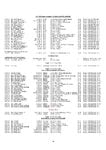Wildcat
Major
Gents, looking for info on the Luftwaffe raid against Bournemouth on the 23rd of May 1943. Could someone tell me what unit(s) were involved? (Fw190's made the attack), German losses and what was their target?
I ask because Bournemouth was the locations of 11 PDRC (Personnel Despatch and Recieving Centre) which was the receiving station for RAAF aircrew arriving in the UK. From what I can gather six RAAF airmen plus many civilians were killed in the raid. Was this a delibrate attack on RAAF personnel or were they simply in the way of a more important target?
I ask because Bournemouth was the locations of 11 PDRC (Personnel Despatch and Recieving Centre) which was the receiving station for RAAF aircrew arriving in the UK. From what I can gather six RAAF airmen plus many civilians were killed in the raid. Was this a delibrate attack on RAAF personnel or were they simply in the way of a more important target?

